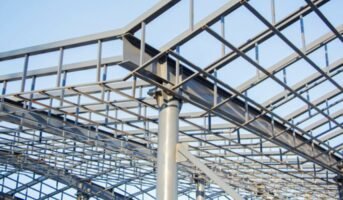Pre-tensioning is a method of reinforcing concrete structures to increase their strength and durability. The process involves applying tension to high-strength steel or tendons before the concrete has fully hardened. This technique is used to improve the load-bearing capacity of concrete structures and to reduce the risk of cracking and other forms of structural failure.
Pre tensioning is an essential aspect of modern construction, as it allows engineers to design and build stronger and more durable structures. It is especially useful in high-stress applications, such as bridges, high-rise buildings, and sports facilities, where traditional concrete reinforcement methods may not be enough to ensure the long-term stability and safety of the structure.
Pre-tensioning: What are the steps involved?
- Preparation of tendons: The first step is to prepare the high-strength steel tendons or cables that will be used in the pre-tensioning process. This typically involves cutting the tendons to the desired length and attaching anchorage systems to the ends.
- Placement in formwork: The tendons are then placed in the formwork or the mould that will be used to cast the concrete. The tendons must be positioned in a manner that will allow them to be tensioned properly once the concrete has hardened.
- The casting of concrete: Once the tendons are in place, the concrete is cast and allowed to partially cure. The curing time may vary depending on the type of concrete and the ambient temperature, but it typically lasts for several days.
- Tensioning of tendons: After the concrete has partially cured, the tendons are tensioned to their design specifications using specialised equipment. This transfers the tension from the tendons to the concrete, providing added strength and stability to the structure.
- Final curing of concrete: After the tendons have been tensioned, the concrete is allowed to fully cure. The curing time will vary depending on the type of concrete, but it typically lasts for several weeks.
- Removal of formwork: After the concrete has fully cured, the formwork is removed, revealing the pre-tensioned concrete structure. The tendons are typically encased in a protective sleeve to prevent corrosion.
Pre-tensioning: Applications
- Bridges: Pre-tensioning is commonly used in the construction of bridges, particularly for the construction of bridge decks and beams. The use of pre-tensioned concrete helps to reduce the weight of the bridge and increase its stability and durability.
- High-rise buildings: It is often used in the construction of high-rise buildings to provide additional strength and stability to the structure. The use of pre-tensioned concrete can also help to reduce the weight of the building and increase its resistance to seismic activity.
- Parking structures: It is also commonly used in the construction of parking structures. The use of pre-tensioned concrete helps to increase the strength and stability of the structure, reducing the need for additional reinforcements.
- Industrial and commercial buildings: It is often used in the construction of industrial and commercial buildings, including warehouses, distribution centres, and office buildings. The use of pre-tensioned concrete helps to increase the strength and durability of the structure, reducing the risk of structural failure and increasing its lifespan.
- Sports facilities: Pre-tensioning is sometimes used in the construction of sports facilities, such as stadiums, arenas, and gymnasia. The use of pre-tensioned concrete helps to provide a stable and durable platform for athletic events and competitions.
Pre-tensioning: Advantages
- Improved strength and durability
One of the main advantages of pre-tensioning is that it significantly increases the strength and durability of concrete structures. The added tension from the tendons provides additional support to the structure, reducing the risk of cracking and other forms of failure.
- Reduced construction time and cost
Pre-tensioning is a relatively fast and cost-effective way to reinforce concrete structures, as it eliminates the need for traditional forms of reinforcement, such as steel bars. This can reduce the overall construction time and cost, as well as make it possible to construct larger and more complex structures.
- Increased control over concrete cracking
It provides improved control over concrete cracking, as the tensioned tendons prevent the concrete from cracking under stress. This helps to extend the lifespan of the structure and reduces the need for maintenance and repairs over time.
- Improved dimensional stability
It can improve the dimensional stability of concrete structures, as the tensioned tendons counteract the effects of shrinkage and temperature changes. This helps to prevent structural distortions and cracking, ensuring the long-term stability of the structure.
Pre-tensioning vs post-tensioning
| Pre-tensioning | Post-tensioning |
| Pre-tensioning is done in the factories therefore ideal for precast building tasks | In addition to being done on-site, post-tensioning may also be performed in a factory. |
| The strands, or prestressing cables, are tensioned before the concrete is poured, creating a mould that encloses the cables inside the concrete. | In this kind of concrete, the strands are encased inside a duct in the form prior to the casting of the concrete. After the concrete has attained adequate strength, the operation of tensioning the strands is performed. |
| There will be construction of small segments | Since the size of a member is not limited, post-tensioning is used to build long-span bridges. |
| Loss of prestressing is around 18%. | Loss of prestressing is around 15%. |
| Pre-stressed components that are identical in size and shape are manufactured using this process. | Products are changed according to a structure. |
| Pre-tensioning members are cast from a mould. | Cables are substituted for wires, and jacks are used for stretching. |
| The concrete is pre-stressed using tendons prior to placement. | Prestressing is performed after the concrete has reached its final strength. |
| Pretensioning is recommended when the structural member is small and transportable. | When a structural member is heavy, post-tensioning is recommended. |
| It is less expensive since it does not need sheathing. | Utilisation of sheathing increases the cost. |
| Greater dependability and longevity | Both anchoring mechanisms are crucial to durability. |
FAQs
Why use pre-tensioning in construction?
Pre-tensioning provides improved control over concrete cracking, increased dimensional stability, and a more uniform distribution of forces in the structure.
What materials are used in pre-tensioning?
High-strength steel tendons or cables are used in pre-tensioning.
How is the tension in the tendons maintained in pre-tensioning?
The tension in the tendons is maintained through the use of anchors at both ends of the tendons and by maintaining the integrity of the concrete around the tendons.
What are the advantages of pre-tensioning over post-tensioning?
Pre-tensioning provides improved control over concrete cracking and increased dimensional stability, while post-tensioning provides more versatility in terms of tendon placement and greater accuracy in tensioning.
| Got any questions or point of view on our article? We would love to hear from you.
Write to our Editor-in-Chief Jhumur Ghosh at [email protected] |
Housing News Desk is the news desk of leading online real estate portal, Housing.com. Housing News Desk focuses on a variety of topics such as real estate laws, taxes, current news, property trends, home loans, rentals, décor, green homes, home improvement, etc. The main objective of the news desk, is to cover the real estate sector from the perspective of providing information that is useful to the end-user.
Facebook: https://www.facebook.com/housing.com/
Twitter: https://twitter.com/Housing
Email: [email protected]











